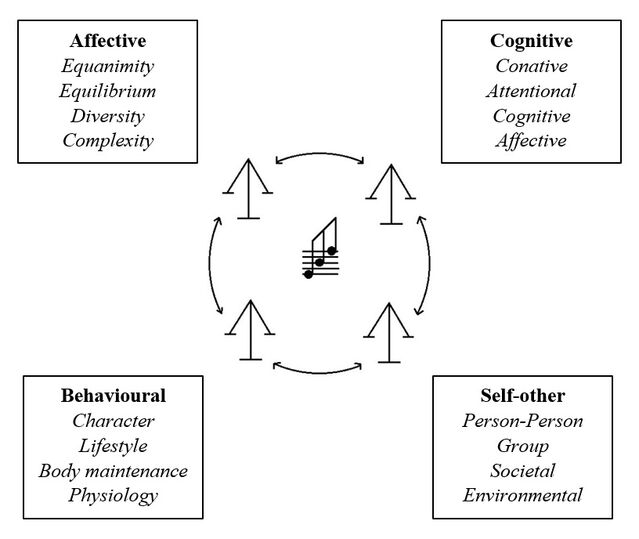Intelligence
Why Are Balance and Harmony So Vital for Well-being?
These dynamics may be a golden thread running through all aspects of flourishing
Posted February 1, 2021

The Importance of Balance and Harmony
What comes to mind when you think of well-being? Perhaps health and happiness, love and relationships, safety and security, prosperity and success, meaning and purpose, and so on. These are all of course valuable, and often even necessary.
But what about balance and harmony? These are potentially less obvious, but may be among the most important qualities of all. As I've explored in a new article1, balance and harmony (B/H) are not merely relevant to well-being, but a "golden thread" running through its myriad dimensions. As such, an overarching definition of well-being might be the dynamic attainment of optimal balance and harmony in any — and ideally all — aspects of life.
Under-Appreciation of Balance and Harmony
However, the relevance of B/H to well-being has generally been under-appreciated in psychology. Even though these concepts have received considerable attention across different contexts (e.g., "work-life balance"), this literature is fragmented and scattered. There have been few attempts to bring these threads together or to centre these concepts as foundational across all aspects of life.
This omission may reflect the Western-centric nature of psychology: mostly conducted by and on people from WEIRD places (Western, Educated, Industrialised, Rich, and Democratic)2, shaped by the values and traditions of the USA in particular. While avoiding crude "East vs. West" comparisons that erase the complex heterogeneity of these regions, B/H have historically been less emphasised or valorised in the West relative (which developed a preference for "linear" analytic modes of cognition, influenced by interpretations of Aristotelian logic promoting ‘either-or’ thinking3). By contrast, Eastern cultures have cultivated more holistic, dialectical forms of reasoning, including notions of balancing or harmonising binaries and multiplicities, as exemplified by traditions like Taoism.
That said, B/H have not been disregarded in the West or by psychology, historically or currently. Indeed, across academia, many disparate references to B/H can be found. Moreover, B/H may be more universally valued than often realised. An analysis of lay perceptions of happiness worldwide — including in Western countries — found the most prominent category was Harmony/Balance (comprising, besides balance and harmony themselves, features such as inner peace and serenity)4. However, despite B/H having been invoked in manifold ways in psychology and related fields, there are few overarching works — with valuable exceptions like the ‘Harmony in Life Scale’5, or analyses by Paul Wong6 — drawing these threads together, or identifying B/H as central to well-being.
Balance and Harmony in All Aspects of Life
With this in mind, I searched for references to B/H across psychological (and related) literature. Overall, balance tends to refers to the quality of relationship between two interlinked phenomena, whether spectral (i.e., poles of a spectrum, e.g., hot-cold) or categorical (i.e., dichotomous categories that are often linked, e.g., work-life). Then, although sometimes used interchangeably, harmony can denote the relationship quality between multiple such "balancing acts" (e.g., among people in a group)7. Beyond these basic definitions, B/H were deployed as concepts in dozens of different ways and in many disparate contexts. I organize these thematically, and arrived at four overarching categories, encompassing numerous interrelated concepts, as illustrated below.

There is no room to cover the actual literature here, so do see the paper for details. Nevertheless, below are examples of the concepts relating to B/H that figure in each category, with a description of how they relate to well-being:
Affective Balance and Harmony
- Affect balance: an optimal ratio of positive to negative affect (i.e., mostly but not only positive emotions)8.
- Emotional equanimity: "neutral" emotions (i.e., minimal positive or negative affect) that are nevertheless tilted towards positivity (i.e., low arousal positive affect)9.
- Emotional equilibrium: emotional homeostasis, involving a capacity or tendency to swiftly return — from either negative or positive affect — to a neutral baseline10.
- Pleasure-pain balance: the need for at least some pain sensitivity (e.g., for learning, protection, and behavioural regulation)11.
- Mature happiness: the existential insight that personal development and fulfillment may involve (or even require) experiences of suffering12.
- Emotional complexity: having diverse and well-differentiated emotions, ideally in harmony (rather than fragmentation or tension)13.
Cognitive Balance and Harmony
- Conative balance: an optimal motivational balance (i.e., avoiding apathy and obsession)14.
- Ego resiliency: an optimal balance of ego control, avoiding excessive expression (under-control) or inhibition (over-control) of affect and impulse15.
- Harmonious passion: interests and desires that are well-integrated with other aspects of life (rather than obsessive)16.
- Attentional balance: avoiding attentional deficit (inability to focus) and hyperactivity (the mind excessively aroused or distracted), such as in mindfulness17.
- Cognitive balance: adaptive engagement with reality, avoiding lack of engagement (absent-minded or inattentive) and over-engagement (imposing biases and projections)18.
- Flow: absorption arising from a balance between task demands and capacity to manage (i.e., being neither too easy nor too difficult)19.
- Affective balance: ability to skillfully self-regulate the various forms of affect balance above20.
Behavioural Balance and Harmony
- Character: with any given quality (e.g., courage), finding the golden mean between deficiency (e.g., cowardice) and excess (e.g., rashness)21, and moreover harmonising multiple virtues22.
- Lifestyle balance: a harmonious, integrated mix of different activities23, including good work-life balance24.
- Energy balance-related behaviours: an optimal balance of rest and activity (e.g., avoiding insufficient and excessive sleep)25.
- Exercise balance and harmony: avoiding under- and over-exertion, and doing a harmonious mix of endurance, strength, flexibility, and balance activities26.
- Dietary balance and harmony: avoiding under- or over-eating particular foods (and food in general), and having an overall harmonious blend of nutritional elements)27.
- Bodily homeostasis: self-regulation of processes (e.g., the immune or cardiovascular system) within healthy bounds, ideally avoiding being under- (hypo-…) or over-active (hyper-…)28.
Self-Other Balance and Harmony
- Self-in-context: avoiding extremes of individualism (isolation and societal fragmentation) and collectivism (totalitarian denial of agency)29.
- Relationship harmony: a dynamic balancing act of give-and-take across different domains30.
- Interactional reciprocity: fairness in interpersonal interactions (e.g., as per game theory)31.
- Societal harmony: many people co-existing peacefully and interacting productively32.
- Environmental balance and harmony: humans developing sustainable modes of relationship with nature, and the environment itself flourishing33.
Future Directions
Evidently, B/H are relevant across the myriad dimensions of well-being. As ever though, more work is needed to explore these phenomena. For instance, some forms of B/H do not fit neatly into the four categories, such as individuals balancing qualities deemed masculine and feminine34, or society balancing left- and right-wing political agendas35. These merit further research, as does whether there are aspects of life where B/H are not relevant or not valued/sought. It will also be instructive to explore cross-cultural variation in B/H.
In that latter respect, I'm part of an ambitious new project to explore these dynamics globally: the Global Well-being Initiative, a partnership between Gallup and Wellbeing for Planet Earth (a Japan-based research foundation). It is focused on developing new items for the Gallup World Poll that reflect non-Western perspectives on well-being36. Even though the poll has measured well-being worldwide since 2005, its metrics for doing so (such as life satisfaction and high arousal positive affect) could be deemed Western-centric.
Our initial focus has been on Eastern perspectives on well-being (aiming to then augment these with ideas from other world regions). Through debate and discussion, we identified B/H as a key element of well-being — not only in Eastern cultures but for all people. As such, we formulated an item for inclusion in the poll from 2020 onwards, currently phrased as: “In general, how often do you feel the various aspects of your life are in balance?” Through such research, we shall hopefully better understand these vital dynamics at the heart of well-being.
References
[1] Lomas, T. (2021). Life balance and harmony: Wellbeing’s golden thread. International Journal of Wellbeing, 11(1), 18-35.
[2] Henrich, J., Heine, S. J., & Norenzayan, A. (2010). Most people are not WEIRD. Nature, 466, 29.
[3] Peng, K., & Nisbett, R. E. (1999). Culture, dialectics, and reasoning about contradiction. American Psychologist, 54(9), 741-754.
[4] Delle Fave, A., Brdar, I., Wissing, M. P., Araujo, U., Castro Solano, A., Freire, T., … Soosai-Nathan, L. (2016). Lay definitions of happiness across nations: The primacy of inner harmony and relational connectedness. Frontiers in Psychology, 7. https://doi.org/10.3389/fpsyg.2016.00030
[5] Kjell, O. N. E., Daukantaitė, D., Hefferon, K., & Sikström, S. (2016). The Harmony in Life Scale complements the Satisfaction with Life Scale: Expanding the conceptualization of the cognitive component of subjective well-being. Social Indicators Research, 126(2), 893–919.
[6] Wong, P. T. P. (2011). Positive psychology 2.0: Towards a balanced interactive model of the good life. Canadian Psychology, 52(2), 69–81.
[7] Li, C. (2008). The ideal of harmony in ancient Chinese and Greek philosophy. Dao, 7(1), 81–98
[8] Parks, A. C., Della Porta, M. D., Pierce, R. S., Zilca, R., & Lyubomirsky, S. (2012). Pursuing happiness in everyday life: The characteristics and behaviors of online happiness seekers. Emotion, 12(6), 1222-1234.
[9] Lee, Y. C., Lin, Y. C., Huang, C. L., & Fredrickson, B. L. (2013). The construct and measurement of Peace of Mind. Journal of Happiness Studies, 14(2), 571–590.
[10] Golombek, H., & Kutcher, S. (1990). Feeling states during adolescence. Psychiatric Clinics, 13(3), 443–454.
[11] Nelson, E. E., Lau, J. Y. F., & Jarcho, J. M. (2014). Growing pains and pleasures: How emotional learning guides development. Trends in Cognitive Sciences, 18, 99–108.
[12] Wong, P. T. P. & Bowers, V. (2018). Mature happiness and global wellbeing in difficult times. In N. R. Silton (Ed.), Scientific concepts behind happiness, kindness, and empathy in contemporary society (pp. 112-134). Hershey, PA: IGI Global.
[13] Kang, S. M., & Shaver, P. R. (2004). Individual differences in emotional complexity: Their psychological implications. Journal of Personality, 72(4), 687–726.
[14] Wallace, B. A., & Shapiro, S. L. (2006). Mental balance and well-being: Building bridges between Buddhism and Western psychology. American Psychologist, 61, 690–701.
[15] Block, J., & Block, J. H. (2006). Venturing a 30-year longitudinal study. American Psychologist, 61(4), 315-237.
[16] Vallerand, R. J., Blanchard, C., Mageau, G. A., Koestner, R., Ratelle, C., Léonard, M., … Marsolais, J. (2003). Les passions de l’ame: on obsessive and harmonious passion. Journal of Personality and Social Psychology, 85(4), 756–767.
[17] Kabat-Zinn, J. (2003). Mindfulness-based interventions in context: Past, present, and future. Clinical Psychology: Science and Practice, 10(2), 144–156.
[18] Tversky, B., & Marsh, E. J. (2000). Biased retellings of events yield biased memories. Cognitive Psychology, 40(1), 1–38.
[19] Csikszentmihalyi, M. (2000). Beyond Boredom and Anxiety. New York: Jossey-Bass.
[20] Wallace, B. A., & Shapiro, S. L. (2006). Mental balance and well-being: Building bridges between Buddhism and Western psychology. American Psychologist, 61, 690–701.
[21] Niemiec, R. M. (2017). Character Strenghts Interventions: A Field Guide for Practitioners. New York: Hogrefe Publishing.
[22] Schwartz, B., & Sharpe, K. E. (2006). Practical wisdom: Aristotle meets positive psychology. Journal of Happiness Studies, 7(3), 377-395.
[23] Matuska, K. M., & Christiansen, C. H. (2008). A proposed model of lifestyle balance. Journal of Occupational Science, 15(1), 9–19.
[24] Pulcrano, M., Evans, S. R. T., & Sosin, M. (2016, October 1). Quality of life and burnout rates across surgical specialties: A systematic review. JAMA Surgery, 151, 970–978.
[25] Kremers, S. P. J. (2010). Theory and practice in the study of influences on energy balance-related behaviors. Patient Education and Counseling, 79(3), 291–298.
[26] National Institute on Aging (2018). Exercise and physical activity. Washington DC: National Institutes of Health.
[27] Sofi, F., Cesari, F., Abbate, R., Gensini, G. F., & Casini, A. (2008). Adherence to Mediterranean diet and health status: Meta-analysis. BMJ, 337(7671), 673–675.
[28] Al-Jameil, N., Khan, M. F., Al-Rashid, M., & Tabassum, H. (2015). Thyroid dysfunction: An autoimmune aspect. International Journal of Clinical and Experimental Medicine, 8(5), 6677.
[29] Bakan, D. (1966). The Duality of Human Existence: Isolation and Communion in Western Man. New York: Beacon Press.
[30] Pillemer, J., Hatfield, E., & Sprecher, S. (2008). The importance of fairness and equity for the marital satisfaction of older women. Journal of Women and Aging, 20(3–4), 215–229.
[31] Debove, S., Baumard, N., & André, J. B. (2016). Models of the evolution of fairness in the ultimatum game: A review and classification. Evolution and Human Behavior, 37, 245–254.
[32] Ip, P. K. (2014). Harmony as happiness? Social harmony in two chinese societies. Social Indicators Research, 117(3), 719–741
[33] Lomas, T. (2019). The elements of eco-connection: A cross-cultural lexical enquiry. International Journal of Environmental Research and Public Health, 16(24), 5120.
[34] Lomas, T. (2013). Critical positive masculinity. Masculinities & Social Change, 2(2), 167–193.
[35] Lomas, T. (2017). Positive politics: Left-wing versus right-wing policies, and their impact on the determinants of wellbeing. In The Routledge International Handbook of Critical Positive Psychology (pp. 351–367). Routledge.
[36] Lambert, L., Lomas, T., van de Weijer, M. P., Passmore, H. A., Joshanloo, M., Harter, J., ... & Diener, E. (2020). Towards a greater global understanding of wellbeing: A proposal for a more inclusive measure. International Journal of Wellbeing, 10(2).




